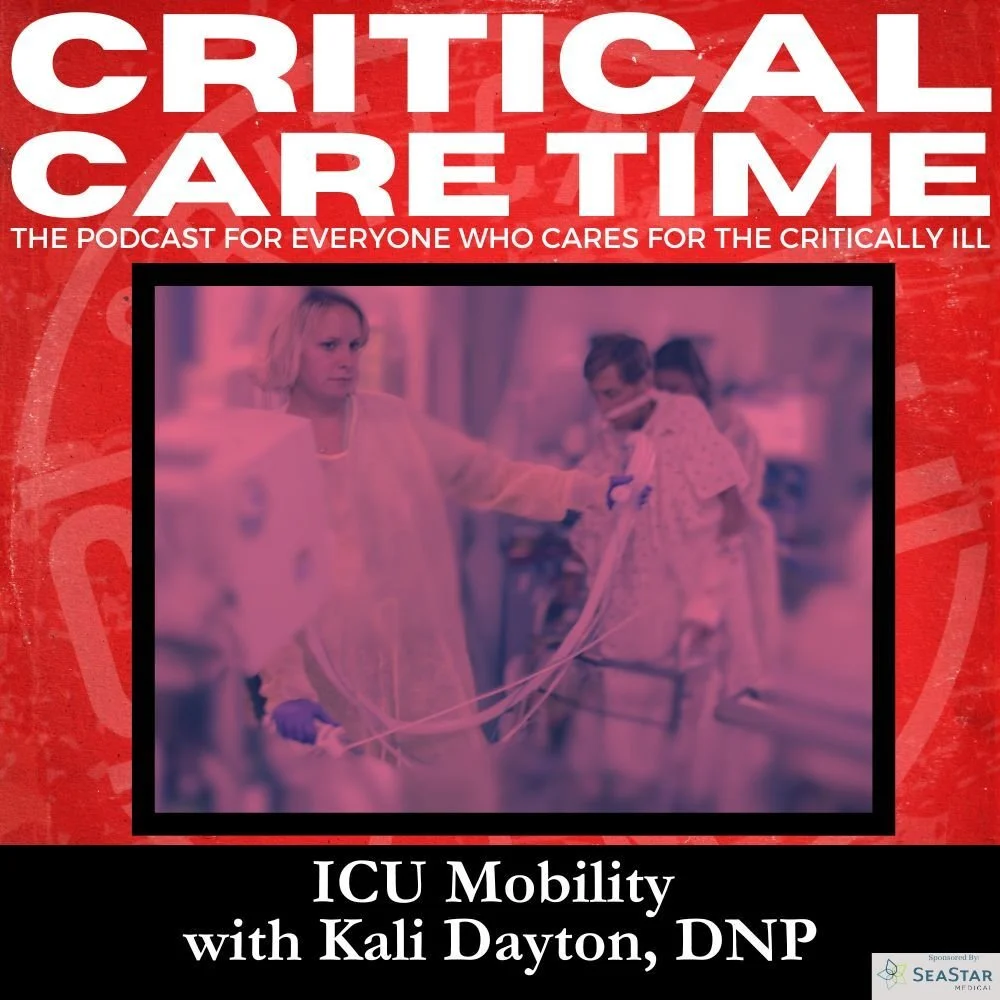#43 ICU Mobility w/Kali Dayton, DNP
The idea that movement is medicine doesn’t stop with the critically ill. On this week’s episode of Critical Care Time we sit down with Kali Dayton, a critical care NP with a passion for ICU mobility. We talk all things mobility in the critically ill: The roles of bedside nurses and clinicians, how we can implement best mobility practices with our patients, the financial and patient-care benefits of fostering a culture of movement in your ICU and what it means to be an “ICU Revolutionist” - along with so much more! If you truly care for the critically ill you cannot miss this episode!
Setting the Stage: Why Mobility is Crucial in the ICU
Immobility causes excess mortality and substantially increased morbidity in ICU patients.
Critically ill patients can lose 2% of muscle mass per day when immobilized.
Millions of people leave the ICU weaker each year. Global burden of critical illness:
13 to 20 million people require ICU-level life support annually (Per ATS & Adhikari NK et al., Lancet, 2010).
This number has likely increased in the past 15 years.
What is ICU-Acquired Weakness (ICU-AW)?
ICU-AW is defined as bilateral symmetrical limb and/or neuromuscular weakness associated with critical illness polyneuromyopathy.
How common is it?
EMG evidence of neuromuscular dysfunction is found in ~50% of ICU patients.
Nearly 100% of patients with sepsis or multi-organ system failure (MOSF) develop ICU-AW.
The Harms of Immobility
Physiological Impacts
Muscle wasting → Persistent functional disability & reduced post-ICU quality of life.
Respiratory deconditioning → Increased risk of ventilator-associated pneumonia (VAP).
Increased risk of pressure ulcers, thromboembolism, and bed-rest complications.
Increased mortality:
The TEAM Study (bi-national, multi-center cohort study) found that >50% of patients discharged from the ICU had developed ICU-AW, which correlated with increased 90-day mortality (TEAM Study).
Psychological Impacts
Delirium, anxiety, and depression are exacerbated by immobility.
Post-Intensive Care Syndrome (PICS):
Affects physical function, mental health, and cognition post-ICU.
Previously discussed with Dr. Wes Ely (Season 1).
Systemic Effects
Increased length of stay, healthcare costs, and mortality rates.
Financial burden:
2008 study: $16,303-$64,421 per patient attributed to delirium.
$38-$152 billion/year in U.S. healthcare costs due to delirium (Study).
2015 study: 30.5% cost increase.
2009 study: 39% cost increase for single delirium episodes.
ABCDEF bundle (A2F) decreases cost by 35%.
Evolution of ICU Practices
Standards of care have evolved towards increased wakefulness and mobility in the ICU:
Spontaneous Breathing Trials (SBT) (1990s)
Sedation Awakening Trials (SAT) (2008)
ABCDEF bundle (2019)
The Walking & Awake ICU (2025?)
Early Mobilization as Standard of Care
Benefits:
Increased muscle strength & functional recovery.
Reduced delirium & improved mental health outcomes.
Shortened ICU & hospital stays.
Call to Action: ICU teams should prioritize mobility from Day 1.
Practical Implementation of Mobility
Defining "early" mobility:
Mobilization should begin as soon as clinically feasible.
What does "mobility" entail?
Bed exercises → sitting → standing → walking.
"Dose" of mobility: How much is enough?
Addressing Concerns & Challenges
TEAM Study paradox: More mobility did not always lead to better outcomes.
Adverse events: Increased in some studies, raising concerns about safety.
Key Considerations for Mobilization
Patient must be:
Awake & unrestrained.
Adequately oxygenated.
Stable enough to tolerate movement.
ICU team should follow the ABCDEF bundle:
Are they awake?
Are they out of bed?
Have we turned off the ventilator?
Where’s the family?
Techniques & Tools for Mobilization
Passive vs. Active Mobility
Equipment Considerations:
Essential vs. Specialized:
Lifts/hoists, tilt beds, walkers, neuromuscular electrical stimulation (NMES).
Are high-tech devices always necessary?
The Multidisciplinary Approach
Roles of:
Physical Therapists (PTs)
Occupational Therapists (OTs)
Nurses
Respiratory Therapists
Importance of teamwork & patient-centered goal setting.
The Link Between Mobility & Nutrition
Mobility facilitates nutrition & vice versa.
ABCDEF → F2A: A framework for integrating function and recovery.
Mythbusting Common Misconceptions About ICU Mobility
"The TEAM Trial showed ambulation isn't effective."
"It’s impossible to ambulate intubated patients safely."
"Anyone well enough to ambulate is ready for extubation."
"Ambulation carries enormous risks and minimal benefits."
"In-bed pedaling is just as good as getting out of bed."
"We don’t have enough staff to mobilize patients."
"If a patient falls, I’ll lose my job."
"It’s inhumane to wake a patient with an ET tube—just let them sleep."
Overcoming Cultural & Institutional Barriers
Breaking the sedation culture → Moving towards an awake & walking ICU.
Institutional challenges:
Resistance from staff unfamiliar with mobility protocols.
Staffing shortages & resource limitations.
Changing the Narrative:
ICU teams must shift from a “culture of safety” to a “culture of outcomes.”
Turning skeptics into advocates for mobility.
ICU “revolutionists” lead the way in transforming practice.
Final Thoughts & Takeaways
Mobility is essential, not optional, in the ICU.
Early mobility improves survival, function, and quality of life.
ICU teams should adopt evidence-based mobility strategies from Day 1.
Where to Learn More
Walking Home from the ICU Podcast:
Deep Dive into the TEAM Study: Episode 117
Search podcast topics: Episode List
Financial Benefits of ABCDEF Bundle: www.ABCDEFBundle.com
Kali’s Website: www.DaytonICUConsulting.com
-
TEAMS
-


